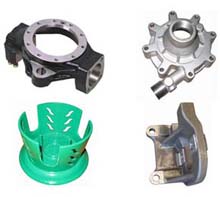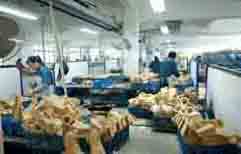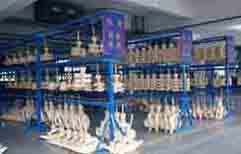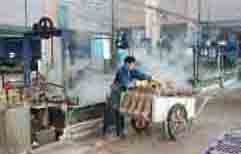Investment Casting
 What is Investment Casting(Lost Wax Casting)?
What is Investment Casting(Lost Wax Casting)?
Investment Casting or Lost Wax Casting is a process for producing near-net-shape metal parts. Parts can be investment cast with a significant amount of detail and typically require minimal finish machining. Investment cast parts are often used in the aerospace, automotive and medical device industries.
When determining the type of investment casting to use, you must first determine the final purpose of the product. Some of the types include: stainless steel casting, aluminum alloy casting, carbon steel casting, brass and bronze casting, lost wax casting, cobalt casting, tool steel casting, metal casting and rapid prototype casting.
The investment casting process begins by producing a heat disposable pattern. This is accomplished by injecting wax or plastic into a metal die. A pattern must be molded for every casting. The patterns are assembled into a cluster (or tree) and are then coated with various liquid ceramic refractories to form a ceramic shell. The wax or plastic is then melted out of the ceramic shell.
Any number of different alloys can be cast into the ceramic mold. After cooling, the ceramic shell is removed and the castings are cleaned.
ADVANTAGES
Excellent surface finish
High dimensional accuracy
Extremely intricate parts are castable
Almost any metal can be cast
No flash or parting lines
Fokli Investment Casting(Lost Wax Casting)
Following more than 10 years' development, we Fokli are now becoming the excellent partner and supplier of Lost wax casting all over the world. Manufactured with optimum quality raw material, our range of Lost wax casting is widely used in various industries.
These are manufactured from quality tested components and are in high demand by our clients spread worldwide. What’s more, these Lost wax casting are available in different types of finishes & can be available in varied shapes & sizes as per bulk buyer's specific need. Fokli lost wax casting: Casting tolerance CT7-CT9, Surface Roughness Ra6.3~12.5, Part weight 0.01KG-250KG The min wall thickness 2mm
The Process of Lost wax casting:
1. Rough Sculptor making: A creative artist makes an original sculptor or mold or an artwork by using raw material like wax, plaster of Paris or clay. A mixture of oil based clay and wax is preferred as these materials retain their softness.
2. Final Mold Making: A mold is then made as per the original sculptor. The mold is made up of two pieces and a key with shim is placed between the two pieces during construction so the mold can be put accurately back together. Molds are generally made using plaster or fiberglass or any other material that may be suitable. An inner mold of latex or vinyl or silicone is put pup preserve the details of the original art work. Generally, the original art work made of plaster mold cracks and breaks during the initial phase of deconstruction. Many a times, numerable molds are required to get the exact replica of the original art work.
3. Filling up the mold: Once the latex and plaster mold is complete and finished, molten wax is poured into the mold till it gets an even coating all around the mold. The thickness of the wax coating is around 1/8 inch. This process is then repeated until the desired thickness is achieved.
4. Removal of wax replica: The hollow wax replica of the original art work is then removed from the mold. The original mold can be used for making more wax replicas, but due to the wear and tear of the original mold the reuse of the mold is limited.Softening: Each wax mold is then chased or softened using heated metal tools. The metal tools are rubbed around portions that show cracks or the joining line of the mold, where the pieces have come together. Separately molded wax pieces are then heated and attached. The finished mold is then dressed in order to hide any imperfections. The final piece then looks like a bronze sculpture.
5. Making paths for molten bronze: It is also known as "spuring", in short the wax copy is then branched with treelike wax, so that the molten bronze reaches the right parts and also it helps the air to escape. The critical and careful spuring begins from the top of the wax copy. The top of the copy is attached to by wax cylinders to different points on the wax copy.
6. Slurry, burnout, testing, pouring, release, metal-chasing, and painting are the final steps in the process of Lost Wax Casting.
Fields of Production:




 Sand Casting
Sand Casting Brake Disc Series
Brake Disc Series Brake Drum Series
Brake Drum Series Differential Cases
Differential Cases Featured Cases
Featured Cases Investment Casting
Investment Casting Cylinder End Mounts
Cylinder End Mounts Shaft Coupling
Shaft Coupling Cast Steel cable Protector
Cast Steel cable Protector Home Hardware Accessories
Home Hardware Accessories Featured Cases
Featured Cases Precision Machining
Precision Machining Hydraulic Piston
Hydraulic Piston Flange
Flange Featured Cases
Featured Cases Precision Stamping
Precision Stamping Featured Cases
Featured Cases Precision Forging
Precision Forging Featured Cases
Featured Cases Die Casting
Die Casting Featured Cases
Featured Cases Gravity casting
Gravity casting Featured Cases
Featured Cases Cold Forming
Cold Forming Featured Cases
Featured Cases Magnetic Assemblies
Magnetic Assemblies NdFeB Magnets
NdFeB Magnets Engineered Assemblies
Engineered Assemblies Magnetic Separators
Magnetic Separators Attraction Kits
Attraction Kits Powder Metal and Sintered Part
Powder Metal and Sintered Part Fokli Sourcing
Fokli Sourcing





 What is Investment Casting(Lost Wax Casting)?
What is Investment Casting(Lost Wax Casting)?

